A short journey from “Hogstie House” to Woburn Sands, via “Hog Sty End”, “Hogsty End”, “Hogstye End”, “Hogs-teen’d”, “On Wooburn Sands”, “The Woburn sands” and “At Woburn Sands”!
I have been asked many times for my opinion of how and when the name Hogsty End changed to Woburn Sands. The local historian Arthur Parker was convinced that it was the story of Joseph Daniels, and his school in the old buildings attached to The Swan, that carried the most weight.
Parker recorded that the old Aspley Guise Schoolmaster, James Mumford, said Daniels had found the name ‘Hogsty End’ of no value to him, as people did not want to send their children to school at the Hogsty End Academy, so he decided to change the title, and the sign became “Woburn Sands Academy”. Confirmation of this would seem to come from a newspaper report of the laying of the foundation stone of the Woburn Sands Literary Institute, in 1874. A person writing at this time possibly have remembered Joseph Daniels and his school:
“Previous to about 1820 this place was called Hogsty End. At about this time a Mr Daniels kept an Academy about 150 yards south of this place. He had a large show board painted on it, “Woburn Sands Academy”; hence commenced the present name of this place.”
Joseph Daniels was evidently a man of some determination, for having invented the title, he made sure that it would be used. In a deed dated 24th March 1812, covering the sale of the site of the cottage in Station Road by Richard Higgins of Sherington (owner of the Swan Inn and farm) to James Young, Daniels is brought in as mortgagee, the description being “Joseph Daniels of Woburn Sands, commonly called Hogsty End in the parish of Wavendon, Schoolmaster.”
Parker wrote he had examined hundreds of deeds relating to local properties, and nowhere before the middle of the century could he find any reference to “Woburn Sands”. He was therefore satisfied that it is to Daniels that we give credit for the birth of the new name. At one time he was convinced that the name was coined by the railway company, and he searched all appropriate records at the British Railway Record Office, but could find no evidence to support it. They have no specific records of the name being given to the Station, but an early reference to it is in a minute of November 1846, when a stationmaster is reported appointed to “Woburn”. However, the first Bradshaw railway guide of 1847 lists ‘Woburn Sands’ as the Station between Fenny Stratford and Ridgmont. The railways adoption of the name set the seal on it, and from henceforth it was “Woburn Sands”.
The hill between Woburn Sands and Woburn was always known as the Sand Hill, and in 1808 a meeting of the toll road Trustees was called for at… “the Swan Inn on the Sands, near Woburn”.
An Issac Cruikshank etching was used in “Eccentric Excursions or Literary and Pictorial Sketches of Countenance, Character, and Country in Different Parts of England and South Wales.” by G. M. Woodward, published in 1817. It shows a carriage stuck in the sand of what is believed to be the hill between Woburn Sands and Woburn (before the cutting though the hill was made), entitled “Stage coach passengers passing the Wooburn Sands Dec 17th, 1796″. Parker said that this again referred to the hill, and not to the place which was not in existence at that time, and it was only on the hill that the sandy mire cause trouble and as Hogsty End was of no importance, the hill was attached to Woburn, which was well-known.
However, all Parker’s research was done before the advent of the internet and the searchable indexes of archive records that we are able to use today. Thanks also to Google, with their project of making the entire texts of out-of-copyright books available, as well as other sources, I have found the following references to the various place names associated with our town:
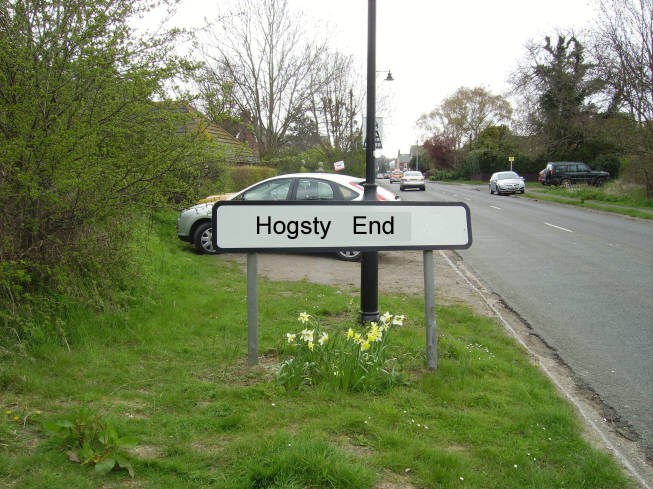
1590 – Duke of Bedford Deeds [Bedfordshire Archives & Records Service, Ref. R6/2/1/1] Among lands sold by Ralph Norwich, late of Aspley Guise, esquire and Anne his wife, sold to Francis Bury, esquire, of Beckerings Park [Ridgmont], was a:
“…plot of land lying between the Ryes Piece and Aspley Wood Corner next to Hogstie House containing half an acre; the last four plots all sold by Edward Sadler and Anne his wife to Edmund Hardinge;”
This is currently the earliest reference I can find directly to the name of ‘Hogsty’ in the locale. Perhaps there was just one house here, to house the farmer in charge of the pigs, and as more cottages were added, they too took the name “Hogsty Houses”.
1679 – The Society of Friends – A long jump till the next reference. The Quakers met locally in this area, and the earliest local record they have of “Hogsty House” comes from October 1679, in a list of collections made from their Meeting Houses.
1681 – High Sheriff Assizes at Bedford [BARS, HSA1681/W/39] “The Examinacon of Thomas Pitman of Clophill in this County Butcher taken the aforesaid xith of October 1680 before me Wm Daniel Esqr & c. This Examint saith that he and the said John Gardiner came on Wedensday the 6th day of this instant October to a village called the Hogsty houses in the parish of Wandon aforesaid, and in the night time of the said day he this Examint and the said Gardiner went to the fould of the said Informt Tho Hart, and the said John Gardiner went into the said fould and lifted out the said eleven sheepe to this Examint and then the said Gardiner helped this Examint to drive them as farre as Litlington and then this Examint drove them home to his house at Clophill, and hath killd foure of them, which said foure & the other seven that are alive wir the same sheepe he and the said John Gardiner tooke out of the fould of the said Thomas Hart at the time and place aforesaid, & further saith not: Wm Daniel”
Locally, Woburn Sands is not the only place-name to have altered over the years. Most early references to Wavendon call it “Wandon” or “Wandone”.
1682 – High Sheriff Assizes at Bedford [BLARS HSA1683/W/37] “The informat. of John Wildes, taken upon Oath the second day of October before mee Thomas Snagge Esqr: one of his Majesties Justices of the Peace for this Cownty of Bedff anno dni 1682 This Informate sayth That about a month since on Fryday night beetweene seaven and eyght of the Clocke, being the five and twentieth day of August last past, sittinge upon the stile on the Kings highway, next the Lane that leadeth beetweene Wooborne and Aspley, John Jenkins passed by him. And the said Informate asked the said John Jenkins whether he was goeinge to Aspley or not, and he answered not, but he was goeinge to Hogsty howse.”
1704 – Aspley Guise Parish Register – Whilst Wavendon gets its first mention in the Aspley Guise registers in 1695, in 1704 the register records that Martha King, widow of Richard, was buried “att Hogsty End in Bucks.”
This is the earliest use of ‘Hogsty End’, as opposed to just ‘Hogsty House’. Obviously, once there was enough cottages in one place, they needed a collective term, and Wavendon was already made up of ‘Ends’.
1707 – Aspley Vicarage Terrier – It was noted that a tythe of wood was collected every year from “…Abraham’s Wood at Hogstie End”
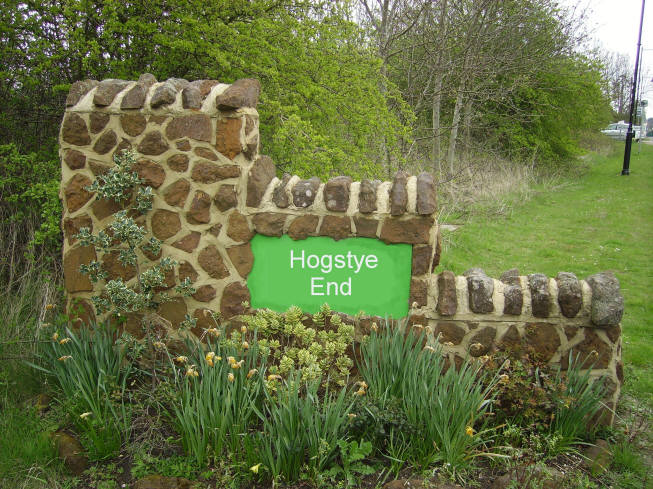
1710 – Wavendon Parish Register, 9th March “Received a certificate signed by Fra. Tyringham Esq. that Richard Underwood Quaker buried at Hogsty End Meeting house (dying at Aylesbury in Prison) was buryed in woollen according to Law.”
Before Woburn Sands had its own church, St Michael’s, on Aspley Heath, villagers usually went to Wavendon church. Here, the incumbents were very good at adding little tit-bits of information to their register, Wavendon parish seems to have run its own Quaker register, separate to the records that the Quakers themselves held. It runs from 1695 to 1753. From the Wavendon Register again:
1722 – Wavendon Parish Register, 21st December
“Received a certificate dated Dec 15th, signed by Herman Hingsberg and Peter Priest searcher of the parish of Allhallows, Lombard Street, London, that Ann How of Asply, Quaker dyed of the small pox and also was Buried in woolen. She dyed at London, Buried in the Graveyard at Hogsty End in the parrish of Wandon in a Leaden coffin.”
1740 – Rev. William Cole “Church End 41, Cross End 9, Duck End 6, In the Heath 5, Hogsty End 12, Longslade 10, East End 14, Green End, Where Mr Selby’s house stands 10”
This local diarist recorded in 1767 how many houses or families were living in the separate Ends of Wavendon in 1740. It totalled 107 households. He thought that about 20 houses had been built since then, mostly in “Hogsty End, Leyton Hollow and Longslade.” Longslade was then a community of several houses.
1759 – Derby Mercury, 1st June
“On Tuesday Morning a Grazier near Leicester was robbed on Woobourn Sands of £104 by a Foot-pad, who got into Aspley Wood, and made off, not-withstanding a great Number of People who went in Search of him.”
A robbery by a man on foot. Although this one got away, bandits soon learnt that it was easy to escape if they were on a horse…Here is an early use of the name although the use of the prefix “on” makes it slightly different from saying “at”.
1775 – Lloyd’s Evening Post, 7th April Friday, as Edmund Dicks, Esq; of Close End in Bedfordshire, was coming over Woburn Sands, he was robbed of twenty-three guineas by a highwayman, who observed that he had a watch, but refused it.
The first occurence of a properly spelt ‘Woburn Sands’. [Maybe the highwayman already had a watch!]
1778 – St James’s Chronicle or the British Evening Post, 22nd September About two o’clock last Friday morning the Derby Coach was robbed on Woburn Sands, by a single highwayman, who behaved in a very polite manner; he collected from all the insides, and took 4s 6d from an outside passenger, but returned him half a Crown, and giving the coachman a shilling, rode off.
A very polite Highwayman indeed!
1780 – The Journey from Chester to London, by Thomas Pennant Esq. About eight miles from Newport, at the forty-four mile stone, at Hogsty-house, enter the county of Bedford, on Woburn Sands, seated on the extremity of the range of hills which traverse the east end of the former county and contain the parishes of the three Brickhills. Near the road side are the noted pits of fullers earth that invaluable substance which is supposed to give the great superiority to the British cloth (honestly worked) over that of other nations.
At least Pennant had not encountered a robber, as others did…
1780 – Northampton Mercury 25th December 1780. Last Tuesday was committed our County Gaol, by the Rev. John Hill, Doctor at Laws, John Jones, charged by the Hon. William Cockaine, of feloniously assaulting him on the 15th inst. on Woburn Sands, and taking from him six guineas, a Gold enamalled Watch, value twelve Guineas, and a Cornelian Seal, set in gold, value 2l. (£2) which were all found in his custody. A silver Watch, by Watson; a brace of pocket pistols, by Archer; small pocket case, with a Chester Note, were also found upon him. He had with him, at Kettering, when he was taken, a bay Mare, with a Blaze and Star in her face.
1797 – Northampton Mercury, 16th September “Hogstye-End Statute will be held at the Coach and Horses, on 27th of September. Dinner on the table at One o’Clock.”
The Coach and Horses inn is now known by the sign of The Swan.
1797 – Morning Chronicle, 4th December “On Thursday night the Manchester Mail on its way to London, broke down as it was passing over Woburn Sands; the letters were conveyed to London in a chaise.”.
1798 – The British Tourists or Traveller’s Pocket Companion, Through England, Wales, Scotland, and Ireland. By William Mavor “Soon after leaving Tyringham, reached Newport Pagnell, a small town, situated between the Ouse and the Lovet, near their junction. It flourishes greatly by the lace manufactory, which, however, gives a sickly appearance to the females who are engaged in its fabric. About eight miles from Newport, enter the county of Bedford, on Woburn Sands, seated on the extremity of the range of hills which traverse Buckinghamshire. Near the road side are the noted pits of fuller’s earth; a substance supposed to give British cloth a superiority over that of other nations, and, therefore, its exportation is prohibited. It is a species of marl.”
….but compare that to the 1780 report by Pennant. Was Mavor actually recording his own journey, or recounting someone elses?
1798 – The Times, 30th March
“Last Saturday night, about nine o’clock, two Gentlemen were robbed by a single highwayman, at a place called Hogstye End, on the Woburn Sands, between the towns of Woburn and Newport, of cash and notes to the amount of 80l with which he got clear off.”
The “l” is the old symbol for Pounds Stirling.
1799 – Mirror of the Times, 21st September “A few nights since, as Mr James Bayley, of Wroxhill Farm, in the county of Bedford, was travelling to Fenny Stratford, he was attempted to be stopped between the two public house at Hogstye End, by a man who jumped out of a hedge, and endeavoured to catch the bridle of his horse, who immediately plunged, and had nearly thrown him. Before he could recover himself, the ruffian fired at him in the back of the neck.”
Somewhere between the Swan and the old Fir Tree? The hedges and absence of other buildings made this a good ambush spot.
1805 – An Excursion to the Highlands of Scotland and the English Lakes: with Recollections, Descriptions, and References to Historical Facts. By J. Mawman. “Travelling over the dreary sands of Woburn, and passing through Dunstable, known for it’s manufacture of strawhats, baskets, and toys, we arrived at St. Alban’s. Near the road, on the Woburn sands, were pointed out to us the hills of fuller’s earth, which is the best cleanser of cloth from grease, and is supposed to give to our staple manufacture such a decided superiority over that of other nations.”
1806 – More Miseries!! Addressed to the Morbid, the Melancholy, and the Irritable. By Sir Fretful Murmur, Knt.
A satirical book detailing embarrassing situations, social gaffs and unavoidable accidents that can befall the unwary. Includes this cartoon….
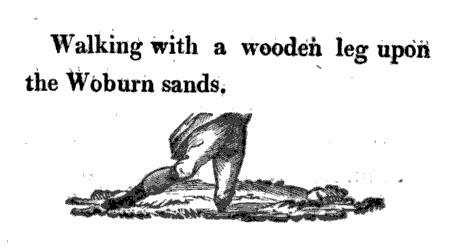
1811 – General View of the Agriculture and Minerals of Derbyshire, by John Farey
“The next characteristic stratum, owing to its forming a Ridge of conspicuous hills through the country, is the Woburn Sand, a thick ferruginous stratum, which below its middle contains a stratum of Fullers-earth, which is the thickest and most pure, in Aspley and at Hogstye-end, two miles N W of Woburn, of any known place: the upper parts of this sand, are frequently cemented by the oxidated iron, into Car-Stone, and the lower parts contain fragments of silicified wood.”
Again, a description more of the specific make up of the soil, rather than the place, but you can see how this would have become common usage for the name of the area, as well as a description, in time. John Farey was a local man, and an agent for the Duke of Bedford, who would have known this area intimately.
1815 – Northants Mercury – “Woburn Sands Statute, commonly called Hogstie End will be held at Mr Hutton’s The Weathercock Inn on Wednesday 20th of September inst. Dinner at One o’clock.”
In 1797, it had been called the “Hogstye-End” Statute. They were clearly moving with the times!
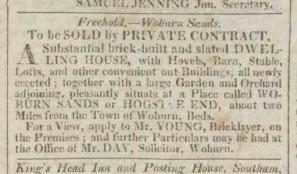
1817 – Northants Mercury February 15th. “Freehold – Woburn Sands – To be sold by Private Contract. A substantial brick-built house……. situate at a place called WOBURN SANDS or HOGSTYE END, about 2 miles from the town of Woburn, Beds.”
If in doubt, use both!
1818 – An Historical and Topographical Account of the Town of Woburn its Abbey and Vicinity, by Stephen Dodd Although Hogsty End or Woburn Sands do not feature in the text, Mr Herbert, Mr Odams and Mr Lee, all of Woburn Sands, are listed in the subscribers. This is the first substantive use as a specific place-name.
1828 – A short story called “The Grumbling Traveller” in The Mirror of Literature, Amusement, and Instruction, by John Timbs. “We were now approaching the end of our first stage. The poor complainant was wakened by the long blast of the horn. More grumbling. “What a bore it is to he annoyed by that booby’s trumpeting.” “It would be a much greater inconvenience,” said the old gentleman, “to wait a quarter of an hour for fresh horses.” “But the fellow need not make so much noise.” “Perhaps he thinks otherwise, and it is not always easy to teach persons in office, to make the most discreet use of authority.” The next interruption was from the coachman – he came to take leave of the company. “What a scandalous imposition in this tax upon the passengers.” The fee was given quite as liberally by lny friend as by the rest of us, but he could not let slip an opportunity of complaining – he thought it a great shame that it was not put a stop to – they had better pay more foi their fare, and be rid of this nuisance. “If that were done,” said the old gentleman, “it would make the matter no better; passengers would soon undo the arrangement by their own liberality; and in the end, we should pay the proprietors more, and the coachmen no less.” It was really very impertinent thus to rob my friend of the comfort of grumbling. “What is the matter now – what is the coach stopping for?” “We are not stopping, we are only going over Woburn sands.” “But why don’t they mend the road?” “It is very difficult to make a good road over such a soil.” “Then why don’t they turn the road?” “Really I can’t tell; but, we shall soon be over it, and after all, the inconvenience is much greater to the horses than it is to us.” At Northampton we stopped to breakfast: and there the old gentleman left us. He very politely wished us a good morning, and a comfortable journey. My companion was quite irritated at the word “comfortable” he thought it looked like a sneer. “What a disagreeable old fool that is,” said he; “I dare say he thinks himself very wise.” “Perhaps,” thought I, “he thinks you very foolish” – but I did not say so.”
Here, the prefix “on” or “the” is dropped and Woburn Sands is used as a specific place-name, yet still with a lower case “S” for Sands..
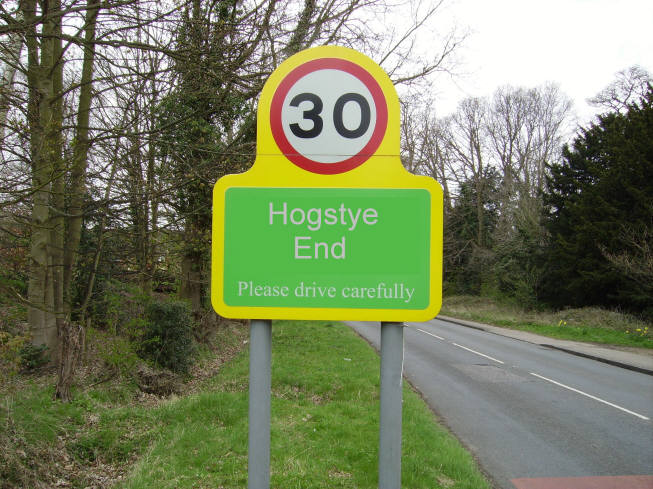
1828 – Jackson’s Oxford Journal, 8th November. “Coach Robberies. On Thursday last as the Northampton coach was returning from town, when arrived near Woburn Sands, it was discovered that the door of the hind boot had been broken open and a number or parcels and other property of no very considerable value stolen therefrom. There was only one outside passenger besides the coachman at the time the robbery must have been committed, and they observed three very suspicious fellows pass the coach a short time before the boot was discovered to be open. Among other property, a travelling bag belonging to the Hon. Robert Smith of Sandhurst is missing; and this gentleman with a truly public spirit, has offered a reward of £50 for the apprehension of the offenders, a sum we believe very far greater than the value of the property lost.”
1830 – The Edinburgh encyclopaedia, conducted by D. Brewster. [Under entry for Bedfordshire] “The most remarkable feature of the Woburn-sand strata, are the beds of fullers-earth which they produce near the bottom. It is believed, that in whatever part of the basset of this sand across England a search is made, the fullers-earth will be found, but generally in thin and foul beds, of no value, and also the siliceous or cherty-stone of a peculiar nature and fracture which lies beneath it, and the specimens of petrified wood which also abound in the same situation; but over several hundred acres at the least, on the north-west of Woburn, both in Aspley Guise parish in Bedfordshire, and in Wavendon in Buckinghamshire, this substance is found from five to seven or eight feet thick, between the beds of sand or sandstone, perfectly free from any extraneous matter.
The original and most extensive workings, which seem of great antiquity, were on Aspley Common Heath, and in Aspley Wood in the same parish; and hence it was truly said, that these celebrated pits were in The Woburn sand is a name for a series of ferruginous sand strata, about 170 or 180 feet thick, whose basset crosses Bedfordshire from Leighton Busard to Potton, as already mentioned, when speaking of the alluvium and peat upon it. In most parts this sand near the surface is cemented by an oxide of iron, into a dark red sand-stone, the grains of silex in which are of very unequal sizes, even in the same specimen. This stone is called car-stone in some places, and was for many years, previous to the roads in Woburn being undertaken by the late Duke’s agent, the sole material used on the roads; and the grinding of it, and subsequent washing away of the ferruginous cementing matter by the rains, occasioned two-thirds in length of those deep, loose sandy roads, (which were the remark and terror of travellers who valued their horses, under the name of the Woburn Sands,) across tracts of alluvial clay, where not the least sand is to be found but what has been brought thither, when in the form of car or sand-stone.
It is much to be lamented, that this absurd practice still continues in the parishes of Wavendon and Broughton, between Woburn and Newport Pagnel, instead of searching for and clean sifting the quartz and flint gravel, which is to be had in sufficient plenty, but at present the only pit (or rather mine, as it is now worked) which is in use, is near Hogstyend, in a point of land in Wavendon, which bends round in rather an extraordinary way into the parish of Aspley. The demand for this article, once so highly prized by the clothiers of this and other countries, has dwindled almost to nothing within twenty or thirty years past. The very great accumulation of alluvial clays on the Caxton range in Cambridgeshire, and these again between Leighton-Busard and Winslow in Buckinghamshire, almost entirely bury and conceal these sand strata for many miles on each side of Bedfordshire. “
“Woburn Sands, the terror of travellers”! By now it has become common as a place-name, although still descriptive also.
1831 – History and Description of Woburn and its Abbey, by James Parry. Under the entry for Wavendon: “In this parish, and that of Aspley, is a large, and now very respectable hamlet, situated on the high road, bearing the unmusical appellation of Hog-stye End: but with respect to the indigenous inhabitants who gave their generic appellation to the spot, it is now only ‘the shadow of a mighty name’ – the echoes of the vicinity now give response to other voices than those of the banished hogs, who might exclaim, in the words of Virgil (with a trifling alteration) – ‘Fuimus porci! fuit Oppidum et ingens Gloria Porcorum!’. The present worthy and talented Rector of Wavendon, is desirous of the erection of a Chapel of Ease at this hamlet, distant two miles from the Parish Church, and containing about three hundred inhabitants.”
1833 – The Climate of London: Deduced from Meteorological Observations, by Luke Howard. “Remarkable Hail Storm in Bedfordshire, 19th, of Eighth mo. 1800. The following particulars of a destructive hail storm in Bedfordshire, were communicated to me by my friend and relation, Richard Howe, of Aspley, who showed me the scars then remaining in the stems of fir trees in his plantation, from wounds inflicted by this hail several years before. There had been thunder showers early in the morning, after which the air cleared up and became very warm. About 7 p.m. after a very heavy clap of thunder and vivid lightning, the hail began, and fell for about ten minutes only; it consisted of balls of ice, of from six to eight or nine inches in circumference. A small one weighed above two ounces; the form was an oblate spheroid, the nucleus the more transparent part. The cloud had an uncommon, fiery appearance, and there was lightning all the evening after. The next evening, also, much thunder, with heavy continued rain. On the third day, the air much clearer and fine; afterwards showery. The storm appeared to originate about Fenny Stratford, and passed in a westerly direction over Hogstye-End, Aspley, Crawley, (missing Woburn,) to Ridgemont, Ampthill, and Clophill, where it ceased, having gone fourteen or fifteen miles, with a breadth of, at most, a mile and a half. The repairs of glass, &c. in this space amounted to several thousand pounds. The corn in shocks, as well as that standing, was in many fields quite thrashed out of the straw. “
While Woburn Sands was becoming common as a term for the southern end of the modern township, I am sure many residents kept to the old name for many years, especially those closest to Wavendon, who regarded it as another “End” of their village.
1836 – Transactions of The Geological Society of London. The greatest expanse of the Lower green-sand in the midland counties, occurs between Leighton and Ampthill in Bedfordshire; rising, at the Ordnance station on Bow-Brickhill, to the height of 683 feet above the sea, – or about 430 feet above the lowest point in the valley on the west of the escarpment near Fenny Stratford. One of the most remarkable subordinate beds of the formation in this neighbourhood, is Fuller’s earth, which, when I was there (in 1824) was brought out by mining from the north-west escarpment of the sand-hills, near Hogstye-end, between the main road from Woburn to Northampton, and that from Hockliff to Stony Stratford.
1837 – The Gardeners Magazine and Register of Rural and Domestic Improvement, by J. C. Loundon “A fine elm, in a field close by the road leading towards Woburn Sands, and about half a furlong from Woburn, was struck by the electric fluid on Thursday last (Aug 24.) and the bark stripped from the top of the highest branch down to the root. The strip appeared very narrow at the top, and gradually increased to about 8 in. in breadth near the bottom, where the electric fluid entered the earth. Another elm, near the residence of Capt. Hoare, in the parish of Wavendon, was also struck, and split from top to bottom, the rent towards the bottom penetrating about a foot into the solid part of the tree (Morn. Citron., Aug.28.)”
Another indication that the name Woburn Sands was favoured more towards the Woburn end of the village.
1845 – The Gentlemans Magazine, 25th November. “Partly in this parish, and partly in that of Wavendon, lies the hamlet of Hog’s-stye-end, containing about 300 inhabitants, a small number of respectable houses, and an ancient Quakers’ meeting-house, in a pleasant situation, of homely and dwelling-house appearance, said to be coeval with the rise of that respectable body. There is also a good inn, which has also been a boarding school, which, before the railroad days, had a considerable traffic. The hamlet stands on the old high road to Manchester, Liverpool, Chester, &c., which runs through Woburn and Newport Pagnell. The former interesting little town, well worth a visit, has also suffered heavily, like some others, from the “mammon” of railway speculation, now needing all the patronage and influence which can be afforded by the Bedford family, its natural protectors, some of whom have done so much for its ornament and benefit. As, however, this name appeared cacophonous to its more polite inhabitants, attempts have been made more than once to “reform it altogether” to “Woburn Sands” or “The Sands,” and partly with success. Still: “Quo semel est imbuta recens servabit Testa diu;” [odorem] and “Hog’s-stye-end,” vulgarly dis-syllabled into “Hogs-teen’d,” yet lives. “
This great quote gives us some idea of the conflict going on between the original inhabitants and perhaps some of the newer home owners, and even some pointers towards the pronunciation! Remember that Salford was known locally as “Safford” and Hulcote was *Huccut”, so locals were used to condensing place names.
1849 – The Gentlemans Magazine “Wavendon. The chancel here has just been rebuilt, through the liberality of Mr. Burney, the present rector. Mr. Fisher, the late incumbent, some of whose poetical works have been reviewed in your Miscellany, sleeps near the east end, externally. “No stone marks the spot;” but probably his family or friends will still erect one. Of the interior, the late Sir Henry Hugh Hoare observed that the lofty arches, with clustered columns, not a common thing in this part of Bucks, or Beds either, were “the best he had ever seen in a village.” He purchased many of the wainscot fittings of old Saint Dunstan’s, Fleet Street; and for his liberal contributions to the rebuilding they presented him with the rich inlaid pulpit, which is accordingly here. Part of the altar-piece forms a screen for the tower, and the remainder will be placed in the chancel. The tower is pretty large and conspicuous, and contains four coarse-toned bells, tenor seventeen hundred-weight. The Heath in this parish and Bow Brickhill – the Wavendon portion purchased of the poor for 100 tons of coals yearly by the Duke of Bedford commands some fine prospects. Service is now performed in a schoolroom at Hogstye End, on Woburn Sands. An account of Aspley may be seen in your Magazine for Jan. 1845.”
An example of both terms in use, describing Hogsty End as being “on Woburn Sands”, and a mention of the school room that figures in the usual story of the town name. I am sure new better-off homeowners would have preferred to tell their friends they were moving to ‘Woburn Sands’ instead of ‘Hogsty End’!
1907 – “The Manchester and Glasgow road; this way to Gretna Green” by Charles George Harper. All the way from sleepy old Woburn to this modern, very much up-to-date, and bristling town of Woburn Sands the road passes through beautiful woodlands, echoing with the voices of pheasants, and rich in the odours of pine and beech and laurel. In midst of this scenery, the half-timbered “Henry the Eighth’s Lodge,” with clipped yew-trees, in shape like so many Stilton cheeses, is very striking. After these solitudes, Woburn Sands comes very much as a surprise, and to some perhaps not altogether a welcome one.
Woburn Sands is an entirely modern name. You will look in vain for it in the pages of Cary or Paterson, for in the old days of the road the place was merely an insignificant hamlet known by the unlovely name of Hogstye End. But things have happened since then. A branch line of the London and North-Western Railway was constructed, crossing the road at this point, and with a station at the roadside. Thus brought into touch with the outer world, the simple souls of Hogstye End arose as one man, and demanded a new name for the place: and so the title of Woburn Sands was invented. Today, the astonished traveller sees a typical twentieth-century township on the site of Hogstye End: a rosy, red-brick place, growing at the expense of Woburn itself; and making strenuous claims to be a health resort, by reason of the sandy soil and the wide-spreading fir-woods. The observant traveller will notice a singular testimony to the belief, until recently prevailing, that the days of the road were done, in the arrogant behaviour of the railway company at this point, in actually encroaching upon the main highway with the out-buildings of their station and the obstructing position of the gates of their level-crossing, often closed for ten minutes at a time during shunting operations.
Even by the early 20th century, the name change was still a topic of interest.
In conclusion, I don’t believe there is a set date for the change of name. I believe that the southern end of Hogsty End, and the road out of Woburn over the hill towards Wavendon, gradually became known as “The Woburn Sands” at the end of the 18th century, and the name was picked up and used by the coaches and passengers who endured the toll road. Then the name stuck locally, and spread northwards towards Wavendon during the 19th century. If there had been one defining name-change moment, it would have been better recorded than by hearsay and local tales.
No doubt, when the school was opened at The Swan, the owner went with the better-sounding name, to attract pupils, and indeed, perhaps the name “Woburn Sands” first appeared in print on a signboard over this school, having only been used verbally before. But it was certainly in existence before that.
When the roads on the ex-Nampak site were laid out, the Woburn Sands Council suggested “Hogsty Lane” for one of them, but the developers refused, saying it would put off prospective buyers. I expect Joseph Daniels smiled to himself in his grave….
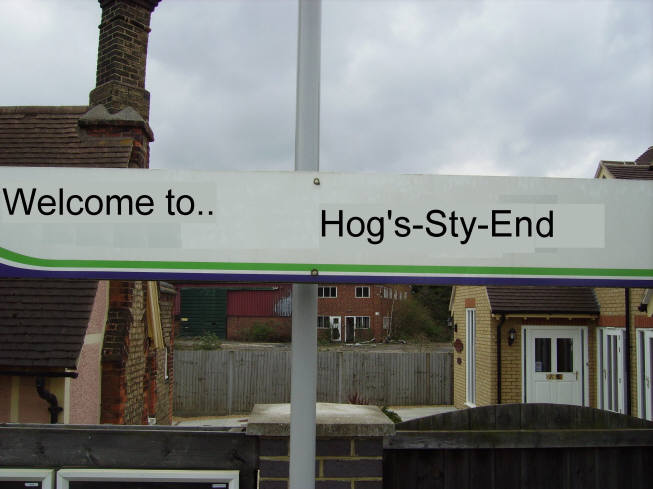
Page last updated Nov. 2018
